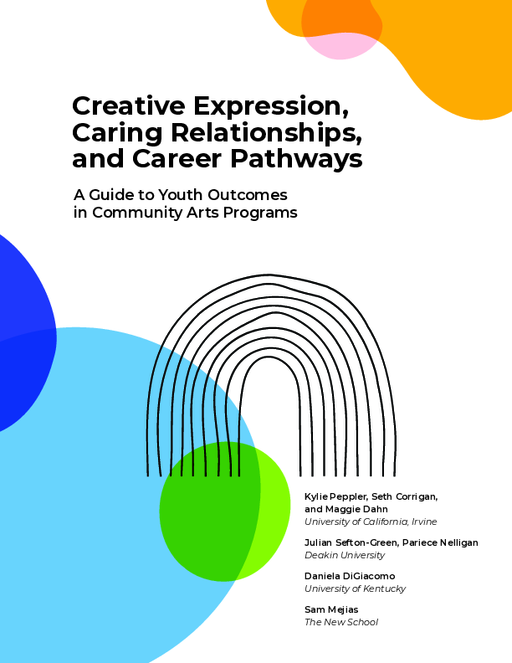- Author(s)
- Kylie Peppler, Seth Corrigan, Maggie Dahn, Julian Sefton-Green, Pariece Nelligan, Daniela DiGiacomo, and Sam Mejias
- Publisher(s)
- University of California, Irvine
Research Approach
The taxonomy is based on the accounts of participants in community-based arts programs. Researchers surveyed alumni of 32 arts organizations in the United States, United Kingdom, and Australia, representing a range of different arts disciplines, geographic locations, and student populations. These organizations were all committed to youth-centered, culturally responsive approaches (i.e., programming that prioritizes the needs and perspectives of young people and incorporates their diverse backgrounds, languages, customs, etc.) with the aim of making a lasting difference in their communities.
Of the 247 alumni who responded to the survey, 102 were chosen for in-depth life history interviews in which researchers asked broad, open-ended—as opposed to yes/no—questions about the long-term outcomes of their time in arts programs, leaving open the possibility that these outcomes may not be all positive. The purpose of these interviews was to shed light not just on the immediate effects of participation—the focus of most program evaluations—but on the ways in which individual participants’ experiences in their programs reverberated over the course of their lives.
The interviewees were an average of 10 years removed from their time in the programs when they were 14 to 24 years old. They were diverse in terms of their race and ethnicity, gender identity and sexuality, and career attainment and life accomplishments. In the interviews, they reflected on their experience in arts programs and how it affected the course of their lives. The interviews, conducted in 2022 and 2023, yielded more than 20,000 pages of transcripts.
The research team analyzed the transcripts for speech patterns indicating that interviewees were talking about the benefits of participation in their arts programs, ultimately gathering more than 7,000 such instances. To find themes in these “outcome statements,” they held a series of workshops over the course of several months, in which the researchers worked with leaders and instructors from some of the arts organizations involved in the initial survey and interviews. Together, they identified 112 categories and 94 sub-categories of outcomes, which were then narrowed down with the help of community arts program leaders to weed out redundancies and make the final taxonomy as useful to the field as possible.
The authors note that this approach stands in contrast to typical measures of program performance, which tend to be based on academic theory; require uniform, school-like assessments; and focus narrowly on a small number of outcomes, such as changes in beliefs, attitudes, or skills. Overall, allowing participants to describe in their own words how participation in an arts program affected their lives, and working directly with arts practitioners to make sense of the data, helped researchers discover a whole constellation of outcomes associated with community arts programs and to describe it in a manner that is consistent with both organizations’ varied goals and their students’ needs and interests.

